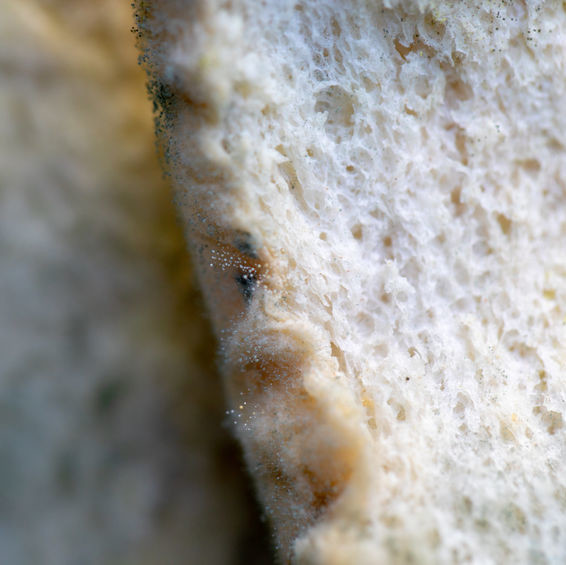
Mold
What is Mold?
Molds are multicellular fungi which are morphologically more complex than bacteria or yeast (single-celled fungi). In foods, they are one of the main causes of food spoilage and foodborne diseases.
- Molds are non-motile, filamentous, and branched microorganisms.
- Their cell walls are composed of cellulose, chitin or a combination of both.
- They typically grow in the form of fine branching filaments called hyphae which can aggregate to form a mycelium.1
Origin
Molds are opportunistic living microorganisms that feed on organic matter, therefore their ability to reproduce in foods. However, they can live in virtually any ecosystem or environment.
In the food industry, these microorganisms are usually seen as enemies. Yet similar to some bacteria, they can be beneficial for certain applications and are used to produce food ingredients and pharmaceutical products.
Mold in the bakery industry
In the bakery industry, along with staling, they are considered the main limiting factors for controlling products shelf-life. Molds that cause spoilage in bread include:
| Mold | Appearance or defect |
| Aspergillus niger | Black |
| Aspergillus glaucus | Green, grey-green |
| Aspergillus flavus | Olive green |
| Penicillium sp. | Blue-green |
| Rhizopus nigricans | Grey-black |
| Mucor sp. | Grey |
| Neurospora sitophila | Pink |
High-speed bakeries strive to keep mold away from their operations and products, especially in high water activity baked goods such as bread and buns. The following table highlights some of the strategies used in bakeries to prevent mold growth (or avoid their development):
| Control factors | Comments | Best control levels / Strategies |
| Water availability (aw) | Lower water activity can effectively slow down mold growth. |
Formulate bread to water activity levels below 0.95 Ingredients that help lower aw:
|
| pH | Low pH or acidic environments can limit mold growth. Acidic conditions can also impact the performance of mold inhibitors. |
Lower the product pH to below 5.6 Low pHs can be achieved through:
|
| Organic material |
Difficult to control since they are essential parts of bakery systems. Any animal or plant material can be used as food for mold. Control here is focused on preventing accumulation of product on food-contact surfaces such as equipment, conveyors and others. |
Proper documentation and implementation of GMP’s prerequisite programs (e.g. cleaning and sanitizing, employee practices, hygienic design). Food management systems (e.g. HARPC of FSMA, HACCP, ISO 22000). |
| Temperature |
Cooler storage and processing facility temperatures can slow down mold growth rate. Kill-steps during processing (e.g. baking, extrusion cooking, pasteurization). Molds and yeast are usually inactivated when the interior temperature of the product reaches about 135–140°F (55–60°C). |
Processing facility temperature: use HVAC systems to maintain temperatures around 68°F (20°C) Product storage temperature: 60°F (15°C) Bake to internal temperature of 205°F (96°C). Thermal profiling is recommended. Cooling to loaf internal temperature of 95–105°F (35–40°C) before packaging to prevent condensation. Freezing and frozen storage. |
| Mold spores |
Fungal spores are particularly widespread in bakeries due to their presence in flour and potential spread throughout the production environment via air movement. Lack of proper cleaning and sanitation practices, recycling of extracted air and/or use of unfiltered air in the bakery increases the presence and accumulation of mold spores. |
Use of ultraviolet or infrared radiation to inactivate mold and mold spores. Use of modified, vacuum atmosphere or anti-microbial packaging to inhibit mold growth. Proper documentation and implementation of GMP’s prerequisite programs (e.g. air and water quality). |
| Preservatives | Undissociated (uncharged) weak acids diffuse through the microbial cell membrane to the cytoplasm, hindering cellular metabolic activities.2 |
Use of mold inhibitors
|
Food safety considerations
Mold itself does not represent a food safety hazard for humans unless there is a serious allergy to food product bacteria. What does represent a hazard, however, is the toxins that they (especially, some species of Aspergillus) can produce. Such mycotoxins are extremely carcinogenic and mutagenic, and can cause serious diseases.3
Peanuts, tree nuts, cereals and milk can carry serious toxins that can be fatal to some people. One key consideration is that mycotoxins are not inactivated in the oven so control needs to be done at the source.
Types of mycotoxins that are poisonous to humans include:3
- Aflatoxin
- Vomitoxin
- Ochratoxin
Post-baking mold contamination control
Post-baking steps are critical for mold control. Coming out of the oven, bread is virtually a sterile product but, upon contact with ambient air and unclean equipment surfaces, the product starts a very slow “mold recontamination process” at the crust (exposed areas). Cooling, slicing and packaging operations must, hence be carried out with high standards of hygiene to help reduce the risk of product infection.
References
- Ray, B., and Bhunia, A. “Characteristics of Predominant Microorganisms in Food”. Fundamental Food Microbiology, 5th edition, CRC Press, Taylor & Francis Group, LLC, 2014, pp. 14–15.
- Msagati, T.A.M. “Preservatives”. The Chemistry of Food Additives and Preservatives, John Wiley & Sons, Ltd, 2013, pp. 233–234.
- Hutkins, R.W.. “Bread Fermentation”. Microbiology and Technology of Fermented Foods, Blackwell Publishing, 2006, pp. 261–298.

